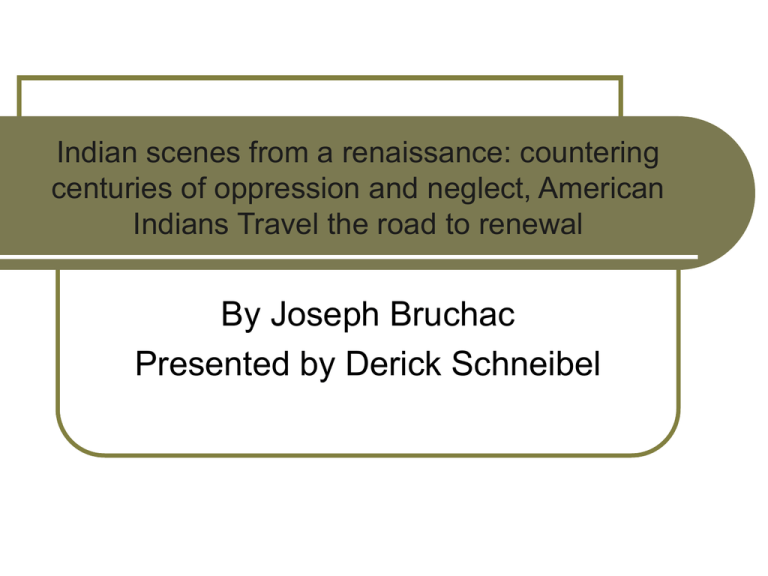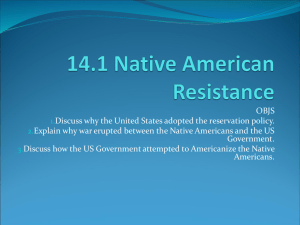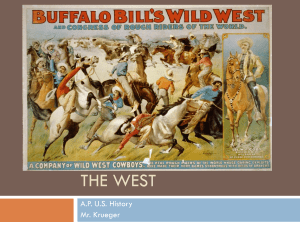Indian scenes from a renaissance: countering centuries of
advertisement

Indian scenes from a renaissance: countering centuries of oppression and neglect, American Indians Travel the road to renewal By Joseph Bruchac Presented by Derick Schneibel 10 Largest Native American Groups Cherokee – 729,533: Oklahoma, California, Texas, North Carolina Navajo – 298,197: Arizona, Utah, New Mexico Latin American – 180,940: Spread throughout U.S. with highest concentration in California Choctaw – 158,774: Oklahoma Sioux – 153,360: Scattered throughout the northern great plains 10 Largest Native American Groups Chippewa – 149,669: Concentrated in the upper Midwest Apache – 96,833: Arizona, New Mexico Blackfeet – 85,750: Montana Iroquois – 80,822: New York, Wisconsin Pueblo – 74,085: Arizona, New Mexico U.S. Indian Reservations Background American Indians make up 1.5% of the total U.S. population 2000 Census total: 4,119,300 1900 Census total: 240,000 Only 13% of American Indians live on reservations 43% of people living on reservations and trust lands are not Indian Comparisons Per Capita Income Living below the poverty line General Pop.:12.4% American Indian Pop.: 22% Unemployment General Population: $21,587 American Indian Population: $14,267 General Pop.: 3.7% American Indian Pop.: 6.6% High school graduate or higher General Pop.: 80.4% American Indian Pop.: 74.7% Sioux; Cheyenne River Reservation South Dakota Goal: Reestablish buffalo culture on reservation Largest tribally owned buffalo herd in America with over 3,000 animals Seeking a federal loan to buy back 22,140 acres of land taken by the government between 1887 and 1934 The “New Buffalo” 224 federally recognized tribes have gaming operations ranging from bingo to casinos Generate about 15 billion dollars annually The Foxwoods in Connecticut operated by the Mashantucket Pequot will gross over 1billion Accounts for only 3% of Cherokee income Oneida Nation; Wisconsin Directed casino profits to tribal development Buying new land, paving roads, and building a new elementary school Founded Four Fires, a business consortium, with three other tribes $43 million hotel near the National Museum of the American Indian in Washington D.C. Chippewa; Bois Forte reservation Minnesota During the 70’s and 80’s wild rice production fell Pressure from outside growers Nett Lake became overgrown with aquatic vegetation 2003 $500,000 of casino profit was invested Motorized barges and cutters cleared the lake Mohawk Nation; New York By 1997 only 5% spoke their native language Mostly in their 70’s and 80’s Formation of Kanatsiohareke meaning “place of clean pot” “Carlisle School in reverse” Graduates now teach other Mohawk Cherokee Nation; Oklahoma Well established language schools Effecting political change Dynamic Lobbying program Use of large numbers to influence politics Discussion Questions In what ways will returning to a buffalo culture help the Sioux? Do you think it is important to preserve American Indian culture, including language? Why or why not? Do you think American Indian history should be a greater part of American History? What do you think should be done about lands promised to the American Indians and then expropriated by the Federal Government? Picture sources Cheyenne River reservation map, http://daschlevthune.typepad.com/daschle_v_thune/mapEB.bmp , accessed 11/25/06 Lakota Sioux Flag, http://www.american-nativeart.com/publication/oglala-lakota-sioux/foto/Oglala-flag.jpg, accessed 11/25/06 Oneida Flag, http://www.crazyhorse.org/museum/flags/OneidaNationOfWisconsin.jpg , accessed 11/25/06 Chippewa Flag, ttp://upload.wikimedia.org/wikipedia/commons/7/7b/Bandera_Chippewa_ Minnesota.png , accessed 11/25/06 Bois Forte reservation, http://www.maquah.net/general_MN/Bois_Fortemap.jpg , accessed 11/25/06 Mohawk Flag, http://www.the-flag-center.com/store/images/Mohawk.jpg , accessed 11/25/06 Cherokee Flag, http://www.atlasgeo.net/fotw/images/u/us-cher2.gif , accessed 11/25/06




